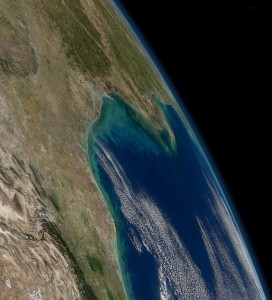Farm fertilizer runoff contributing to Dead Zone
 Photo Credit: NASA Goddard Space Flight Center
Photo Credit: NASA Goddard Space Flight Center
Excess nitrogen is impacting Mississippi River and worsening the Gulf of Mexico’s Dead Zone, according to researchers studying the watershed of the Cedar and Iowa rivers. These scientists have found record levels of nitrogen in the watershed, driven by a combination of drought from last year and high rainfalls from this spring. Nitrogen is making its way into the waterways from synthetic fertilizer spread on conventional farms, polluting local aquatic areas and eventually contributing to the Dead Zone in the Gulf of Mexico. Recent measures of this year’s Dead Zone found that it had doubled in size from last year, likely due to nitrogen and phosphorus pollution runoff from agricultural sources. These excess nutrient levels stimulate algal growth, which can deprive Gulf waters of oxygen and result in massive marine animal and plant die-offs. Nitrogen and phosphorus runoff is also polluting waters throughout the Mississippi River basin and its tributaries, reducing biodiversity and drinking water safety alike. The U.S. Environmental Protection Agency has ordered Iowa and 11 other states in the Mississippi River basin to reduce their contributions of nitrogen and phosphorous to the Gulf Dead Zone by reduced the usage of synthetic fertilizers.


